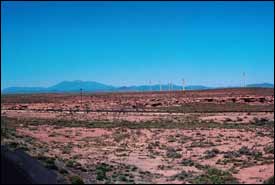
| Supes vote 3-2
for wind farm |
|
| By CYNDY COLE Sun Staff Reporter 04/06/2005 |
|
 |
The five-hour meeting saw the board waver on whether to move the wind turbines away from unhappy landowners next door.
Supervisors Matt Ryan, Louise Yellowman and Carl Taylor voted to allow wind turbine construction on both sides of Interstate 40. Chairwoman Liz Archuleta and Supervisor Deb Hill opposed the vote, preferring to limit construction nearest the landowners.
The site is approved to operate for 22 years, as a partial compromise.
Forty turbines, each with a height of 405 feet, are set to be constructed near Red Gap Ranch on each side of Interstate 40, near the Meteor Crater exit east of Flagstaff. Final approval for some of the turbines located on state lands is still needed from the State Land Department.
When operating at maximum capacity, the wind farm would generate enough electricity to power two-thirds of the homes in Flagstaff.
An appeal from Red Gap Ranch landowners to keep the turbines out of their views of the San Francisco
Peaks by not allowing them to be built north of I-40 was first informally accepted by supervisors, then denied on the final vote. Landowners there and at nearby Turquoise Ranch wanted the turbines moved five miles south of their property.
Red Gap Ranch owner Dave Leyvas wouldn't comment after the vote on whether he'd sue the county. Leyvas' attorney told supervisors that the county had made technical errors in how it decided whether to allow a variance, a way of adjusting county rules to allow for the very tall turbines, which will span 20 feet at the base.
Moving the wind turbines farther south to satisfy the landowners would cost $1 million per mile, said Warren Byrne of Foresight Wind Energy. It could also lead to more bird mortality ultimately hold up construction on a project that must be launched this year to qualify for crucial federal tax credits.
Land owners, environmentalists, developers, business owners and a Northern
Arizona University professor all came to comment on the plan during the meeting,
which lasted more than five hours.
The vote became a test of whether the varying parties supported residential development of the corridor or renewable energy, though no one at the meeting opposed renewable energy --as long as it wasn't in their back yard.
Land next to infrastructure that blocked the view of the San Francisco Peaks could only hurt land values and turn off potential homebuyers, said Stephen Earl, an attorney for the land owners.
Lawyers and representatives for the wind power company, Foresight, said studies showed wind turbines were linked to increased property values in some areas.
"I'm satisfied that the Planning and Zoning Commission drew a correct conclusion" in recommending to allow the towers to be built, Supervisor Carl Taylor said.
The commission had to decide whether land values would drop if the turbines were added. It ruled that they wouldn't.
Lawyers for each side showed photo simulations of what the turbines would look like up close and from afar, and the photos looked fairly different, depending upon the presenter.
Drivers heading west on Interstate 40 would notice the towers for about 10 minutes while looking toward the San Francisco Peaks.
The Grand Canyon Trust, Sierra Club, Northern Arizona Homebuilders, the Hopi Tribal Council and a member of the Arizona Corporation Commission are all in support of the wind farm, which Sunshine Wind Energy has said would spare the air from tons of carbon dioxide, nitrogen oxide and sulfur dioxide emissions, the equivalent of taking 16,600 cars off the road.
"For the benefit of everyone on the planet we have to get these kind of projects moved to the forefront," Supervisor Deb Hill said.
The wind turbines would be generating power about 70 percent of the time.
But the claims of much cleaner air thanks to wind turbines just don't hold weight because Arizona Public Service Company or another potential buyer will use the power as needed, not in place of other power plants, said Bill Towler, head of Coconino County's Community Development Department, which includes Planning and Zoning.
"No coal-powered plant in Arizona is going to cut its production because of this" wind farm, Towler said.
As for other impacts, the turbines will likely kill some birds and bats, but nothing like the higher mortality rates at larger wind farms in other states, one Northern Arizona University professor estimated. Studies on wind power and animals have widely varying results, he said.
"All indications at this point indicate that won't have a significant impact on species," said Tad Theimer, a vertebrate ecologist.
The area isn't known to be a prime migratory corridor for birds or bats, he said, but it deserves more study if wind turbines are established. NAU will have a study site as part of this agreement.
Cyndy Cole can be reached at ccole@azdailysun.com or at 913-8607.
To subscribe or visit go to: http://www.azdailysun.com/
© 2000-2005 Arizona Daily Sun